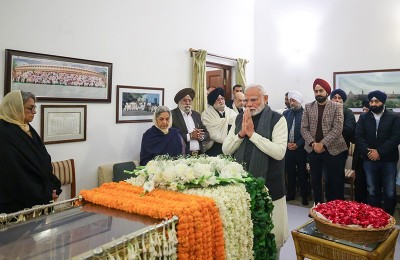 The Girl Child
The Girl Child
International Day for The Girl Child: Education is the biggest weapon to overcome odds
In a remote village in Samastipur, northern Bihar, class 9 student Seema’s (name changed) parents stopped sending her to school because they felt the neighbourhood had become unsafe for her. Across the border, in a remote tea garden area in North Bengal, 16-year-old Ankita Thapa senses the fear and concern in her parents when she returns home late. Her brother, of course, can stay out for as long as he wants.
Reality bites
Why do parents worry about their teenaged daughters’ safety, much more than their sons? Well, a look at the latest findings of National Crime Record Bureau (NCRB) might provide an answer. In Bihar, where Seema lives, there were 6,894 recorded cases of Crime against Children in 2021, and all the victims were girls. In West Bengal, 99 per cent of the incidents of crime happened against girls.
In Odisha, Jharkhand and Assam, three other states in the East where CRY has analyzed data, the situation is as grave as elsewhere.
Violence against girls, especially in their adolescence, can take many forms –physical, sexual and emotional – and varies in its severity.
While all adolescents may experience violence, being a girl presents unique vulnerabilities – some with consequences that can last a lifetime.
Acceptance ofdiscrimination, violence or crimes shrinks a girl’s sense of self, the hours of the day, and their lives. In many communities, this acceptance is a ‘norm’.
The responsibility for preventing violence too often falls on girls: “don’t walk there”, “you can’t wear that”, “don’t go out at night”, “you shouldn’t be alone”. Restrictive advice like this often forces a girl to think and behave in a particular way. They are ‘taught’ to endure,‘forced’ to accept, and kept ‘unaware’ of their rights as individuals.
The latest NCRB figures are a grim indicator of how vulnerable girls remain.Despite a general discourse on empowerment in the country, girls have to bear the burden of the deeply-ingrained gender construct in the society.
2022 completes a decade of the commemoration of International Day of the Girl (IDG). Over the last 10 years, there has, no doubt, been increased attention on issues related to girls amongst governments, policymakers and people.
Girls have got opportunities to make voices heard on public forums in many spheres and taken remarkable developmental strides. Yet, they continue to face challenges to their education, their physical and mental wellness, and the protections needed for a life without violence. Safe and equal access to entitlements, services, social participation, and economic opportunities remain a distant dream.
The ray of hope
With adversities and stumbling blocks, however, come resourcefulness, creativity, tenacity, and resilience. Young girls have shown time and time again that given the skills and the opportunities, they can be change-makers in their communities.
We meet 16-year-old Anju (name changed) a few villages away from where Seema lives. Her parents, both farm workers, had stopped her education when she was a mere 12 years, and started looking for a “suitable groom”. Desperate, Anjuhad reached out to JJBVK, a partner organization of CRY, working in the area.
Four years of activities, supplementary classes, life-skills and more – from a helpless 12-year-old cowed down by family, Anju today is a confident young girl aware of her rights as an individual.
Not only has she convinced her own parents to stop thinking about her wedding, she has made other families in the neighbourhood ponder about the perils of child marriage, and the importance of educating their girls. She herself is studying in Class XI and is determined to become financially independent.
Educate a woman, educate a nation
Anju has hit the nail on the head: Education of girls is perhaps the biggest arsenal in the armory, to ensure that they live a ‘fulfilling’ life.
In our country, many people are unaware of how a girl’s education can change her lives for the better. In underprivileged communities, parents are willing to arrange for ‘dowry’ for their school-going daughter, but not for her schooling.
Recent government data (NFHS-5) reveals that 4 out of 10 women aged 20-24 (40 per cent) in Bihar and West Bengal were married before the age of 18.
What parents don’t realize is that the education of a girl goes much beyond just enrolling her into a school. She should be made to feel safe while in school and have equal opportunities to complete her education.
She should acquire knowledge and training to compete in the labour market and should be taught life skills necessary to adapt to the fast-changing world. It is also important to build their self-esteem and confidence to rise above outside influences, and peer pressure as well as pressure from family.
Self-esteem is built up over time and goes hand in hand with confidence. It is a blend of thoughts, opinions, and feelings a girl has about herself and as such, it can change based on the way a girl thinks.
When a girl is educated, she is empowered. She can make crucial decisions for herself, and not have to wait for her family’s consent for important developments in her life. Girls like Seema can bounce back and resume studies.
Government data on education (as per UDISEanalysis) points to a welcome decline in the drop-out rate of girls over the past five years, but the pandemic has, undeniably, eaten into much of the positives.
It has increased the vulnerabilities of girls in many ways – they are at a greater risk of forced marriages and drop-outs, mainly because of widespread economic downturn, school closures and interruptions in reproductive health services.
It’s time to take stock with renewed vigour and plug the gaps that have opened up.75 years since independence, young girls in this country are entitled to safe and inclusive spaces, at home, in school and even on public forums.
Freedom is liberation of thought. Freedom is to pursue one’s dreams and expressions. Freedom is the will to fight out the odds. Let our girls have them all!
(Opinion expressed in the article is that of the author)
Support Our Journalism
We cannot do without you.. your contribution supports unbiased journalism
IBNS is not driven by any ism- not wokeism, not racism, not skewed secularism, not hyper right-wing or left liberal ideals, nor by any hardline religious beliefs or hyper nationalism. We want to serve you good old objective news, as they are. We do not judge or preach. We let people decide for themselves. We only try to present factual and well-sourced news.







